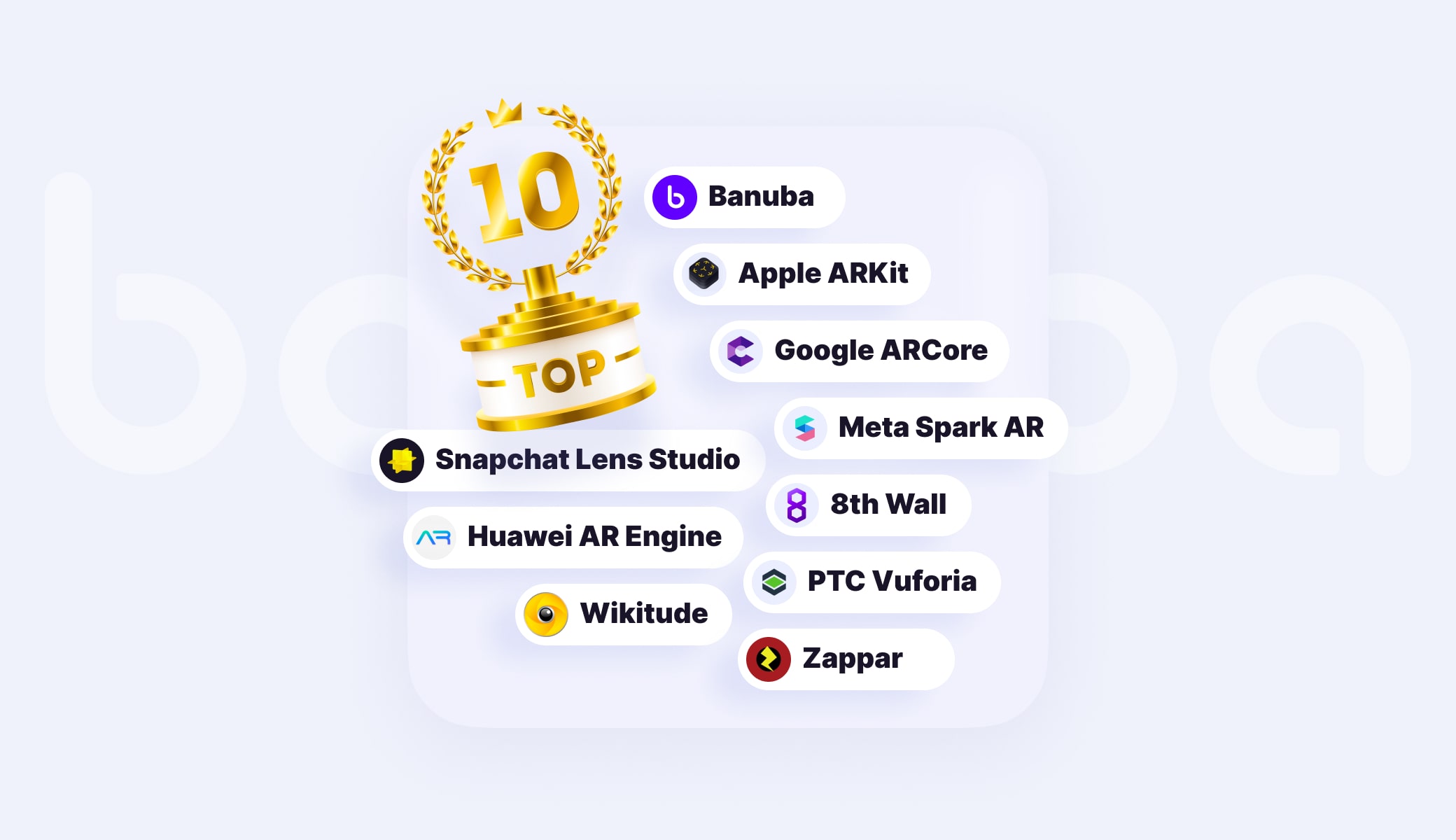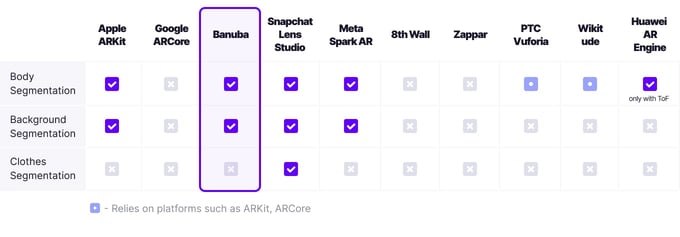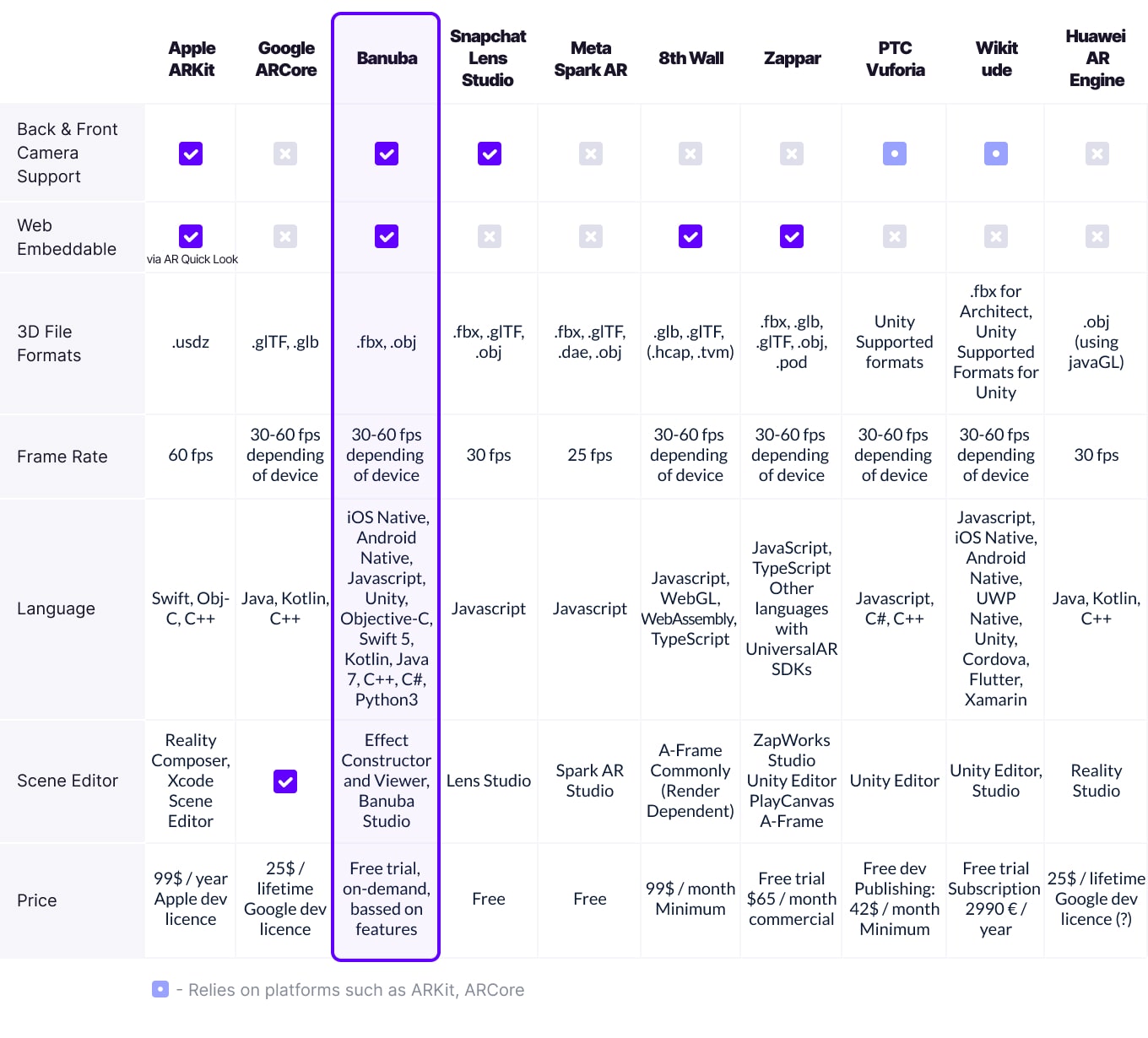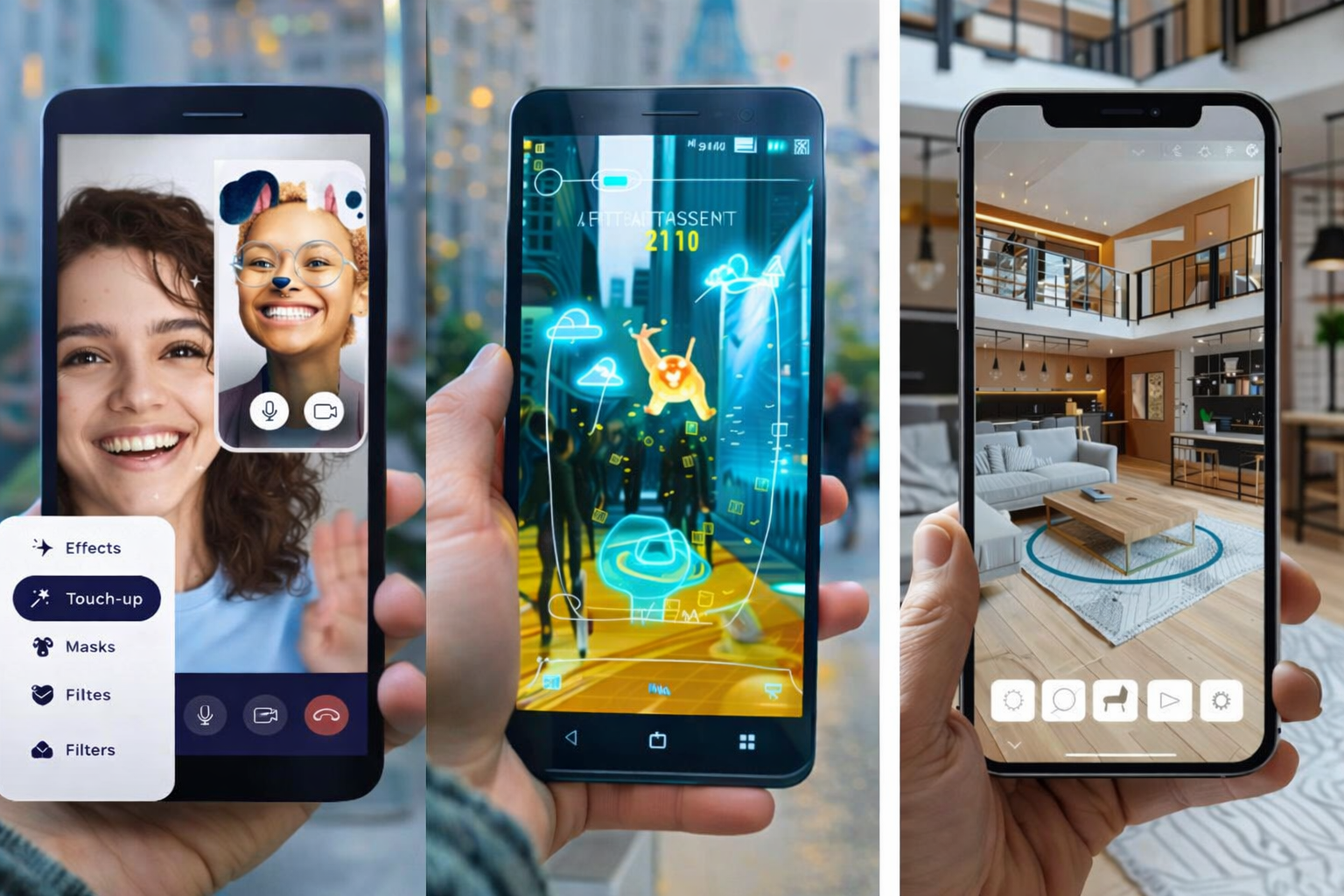10 Best Augmented Reality Kits For Mobile AR Development [2024]
Augmented reality kits help empower your iOS/Android app with an immersive AR experience.
But how to choose the right free/paid AR framework for your business?
In this guide, you'll learn the 10 best augmented reality software development kits and 5 tips to choose the right one.

AR Development Platforms 101
An augmented reality kit (AR kit) is a collection of frameworks and libraries that let developers build their AR-powered apps.
Augmented reality software development kit is often referred to as AR SDK or platform. And there’s no big difference between them. They both represent self-sufficient and well-documented AR development platforms that empower you with all the tools for creating a custom AR experience.
How You Benefit from Using an AR Kit
- Ready features. An AR kit provides ready-coded functionality, so you don't need to reinvent the wheel.
- Scalability. If you want to add more functions in the future, e.g. video editing features, you can easily do so while staying within one platform and keeping your code clean.
- Faster time to market. Instead of spending months developing a feature, you can integrate it ready-made and launch your app way more quickly.
- Ease of use. AR kits are well-documented from the coding point of view. Many include AR templates that help you design a custom experience.
- Communities. The popular AR platforms assembled an extensive knowledge base and millions of devotees who can help you address issues.
10 Best Augmented Reality Kits for Mobile AR Development
Banuba
Banuba Face Filters
Banuba is an AR solution company that provides a multi-platform augmented reality developer kit. It lets you create apps with AR filters, beautification, and 3D animation.
Along with Face AR, the Banuba kit provides Video Editing and Hand AR features that open many use cases in video conferencing, social networking, and live streaming apps.
The core advantages and features include:
- Face tracking and hand tracking optimized for low-end devices
- Realistic 3D rendering
- A range of face segmentation neural networks that let you recolor and change users’ hair, eyes, and lips
- Background removers for portraits and full-body videos
- AR Studio where you can construct custom filters
- Asset Store where you can license ready filters for your app.
The platform is best for mid and enterprise companies and startups who create communication, entertainment, video editing, and camera apps.
Price: 14-Day free trial and a subscription-based license depending on features.
Apple ARKit
Apple has been vigorously developing its augmented reality platform ARKit for almost 5 years.
Today, it’s one of the most feature-rich augmented reality toolkits letting you create apps for iOS.
The core features include:
- World Tracking
- Real-Time Mapping
- Multiplayer
- Semantic Segmentation
- Occlusion
- Device motion tracking
- Camera scene capture
- Advanced scene processing
- And many others.
Most likely, it will be integrated with the long-awaited XR device, so more and more developers launch their apps and games with ARKit.
At WWDC 2021, Apple introduced the latest version of ARKit 5 and RealityKit 2. It’s an enhanced version of the high-quality AR platform. It includes object capture, surface realism, and post-processing.
Price: 99$/y Apple dev license.
Google ARCore
ARCore is an open-source free augmented reality SDK by Google.
Simply put, it's Google's response to Apple's ARKit. It can detect motion sensations and determine the size and position of horizontal and vertical landmarks through the smartphone camera, opening almost limitless opportunities for developers to create AR apps for Android. Among ARCore’s major updates announced at Google I/O 2021:
- access to the new Raw Depth API. It gives a drastically clearer geometry of virtual objects and a much higher positioning accuracy.
- an API for recording and playing data from the camera that speeds up the app development and testing.
Price: 25$/lifetime Google dev license.
Snapchat Lens Studio
Lens Studio is an augmented reality platform by Snap Inc for Snapchatters. Its major focus is AR lenses, a quick mobile AR development toolkit for social media, AR advertising, and entertainment.
Note, you can publish them only within the Snapchat ecosystem, namely the Snapchat app, third-party apps with Camera Kit, Spectacles AR glasses and Snap camera for desktop.
Together, their audience accounts for 200M Daily AR users and 250K Creators. The latter tribe is actively growing due to the relatively low entry threshold into Lens creation in Snap Studio. Besides, Snap has big plans for 2023, and the recent updates only prove that. Among the add-ons:
- Installable content which lets you create your Lens using templates.
- Cloth Simulation that realistically renders fabric surfaces to create virtual clothing try-on filters.
- Foot Tracking to interact with attached objects and activate various effects with your feet.
The tool is best for AR creators, and retail brands looking to attract Gen Z customers.
Price: Free
Meta Spark AR
Spark AR is a promising augmented reality development kit by Meta for novice developers and designers. You can become one of the first effect creators for Instagram and pick low-hanging fruits. So far, only 400 thousand people have tried to create AR at least once in Spark AR Studio.
- AR quizzes
- Hand tracking
- Body tracking
- Multipeer API/group effects
- Unique background replacement
- And many others.
Additionally, Meta is launching a light version of Spark AR Go for creating simple filters right on your phone.
While it’s still in beta testing, it has a huge potential to drive AR creators and businesses in mass.
Big brands, of course, will continue to work with agencies and studios, but small businesses will be able to adopt AR at a low cost.
Price: Free.
8th Wall
8th Wall has established itself as the most popular and universal Web AR platform.
Key Web AR features include: World Effects, Image Targets, AR Face Effects.
And for the convenience of creating a Web AR experience, 8th Wall developed No-Code Cloud Editor and Code Cloud Editor.
They also launched Reality Engine, an engine that automatically adapts the WebAR experience for different devices, including smartphones, tablets, computers, and AR/VR/MR headsets.
In fact, this is a huge update that brings important benefits:
- Cross-platform interface. The interface of Web AR applications will automatically adapt to the user's device.
- Cross-platform Input System. From any device, the user will be able to control the AR experience, both using VR controllers and gestures, a computer mouse, or touching the screen.
- Adaptive environment. The content will be displayed in a different environment, depending on the device, in AR, or just in 3D.
Recently, the 8th wall has joined Niantic, the most popular AR game producer. The 8th Wall platform will remain a stand-alone part of Niantic Lightship.
Price: starts from $99/mo.
Huawei AR Engine
AR Engine lets developers create augmented reality apps for Android. It integrates AR core algorithms to provide basic AR capabilities such as Motion Tracking, Environment Tracking, and Body and Face Tracking.
Its unique feature is a Health check. The technology catches facial health indicators and estimates health parameters in real-time, including the heart rate, respiratory rate, facial health status, and heart rate waveform signals.
Price: Google developer license
PTC Vuforia
Vuforia is a leading platform for enterprise and manufacturing augmented reality apps.
Its developer’s kit’s key features are powerful Object Recognition (via uploaded 3D models or 3D object scan), Image Recognition and Plane detection. Their latest updates include features that significantly broaden possibilities and optimize performance:
- Vuforia Engine Area Targets along with Area Target Generator
- Scanned Model Targets
- Advanced Model Targets for multiple model detection
- Continuing work with applications paused
- Simulation mode
- Vuforia Engine Tracking Scale.
Price: Free developer licence, $25 /month min when publishing
Wikitude
Wikitude, a Qualcomm company, stands behind many award-winning AR solutions for mobile. Accenture, Disney, Nissan, and UNESCO are among the famous brands that chose its platform.
The Wikitude kit includes markerless 3D AR, Image and Object Tracking, Instant tracking (SLAM), and Geo AR.
It is an ideal solution for creating games and marketing applications for retail, consumer, or media companies.
Along with broad framework choices including JavaScript, Unity, Cordova, Xamarin, Flutter, & Native API, the Wikitude platform supports smart glasses like Epson Moverio, HoloLens, and Vuzix.
Price: starts with €2490 for a one-time purchase.
Zappar
Zappar provides an augmented reality platform and creative studio with Face Tracking, Place Detection, and Image Tracking.
The kit includes the Studio and detailed tutorials that let you build custom AR models for print, product, packaging, and retail apps.
It fits both developers and designers, who can create basic AR experiences without solid coding skills.
Among the other advantages of Zappar is its support of mobile and web frameworks, including Three.js, Unity, and A-Frame. Being easily embeddable via the web, users can instantly launch the AR experience using just a browser.
Price: starts from $65/monthly.
Detailed Augmented Reality Framework Comparison
Augmented reality development kits are packed with features. Some of them are implemented with complex computer vision technologies and interconnected with each other.
While the others are standalone neural networks trained to perform a specific task for AR mobile development.
Here is a detailed comparison of the 10 best augmented reality tools by features and their quick explanation.
Face tracking and AR
![]() Face Tracking and AR | Augmented Reality Kits Comparison
Face Tracking and AR | Augmented Reality Kits Comparison
Face tracking lets you detect and track the user's face in real-time to overlay augmented reality filters, AR makeovers, and try on for glasses, hats, and jewelry.
By building a 3D face mesh, the technology can precisely overlay AR filters, and 3D masks and change the shape of the face.
With multiple face tracking, you can create interactive AR lenses for several people in the camera.
Related features:
- Hair Segmentation. Change the color of the hair for virtual hairstyle apps.
- Eye Segmentation. Recolor eyes or let users try on virtual lenses.
- Skin Segmentation. Segment the skin area detected in the camera for makeover effects.
- Lips segmentation. Precisely detect and recolor user lips for virtual lipstick try on filters and apps.
- Actions and Triggers. You can let users trigger effects with facial expressions or create face games.
Best AR Kit: Banuba
Banuba provides the most extensive feature kit for face augmentation.
While most SDKs support face tracking, narrow computer vision tasks come only with Banuba, Spark AR, and Lens Studio.
Unlike the last two, you can use the Banuba AR kit to add filters to your iOS and Android app.
People, Background, and Clothes Segmentation
 Object Segmentation | Augmented Reality Kits Comparison
Object Segmentation | Augmented Reality Kits Comparison
You can detect and separate the human body in images and videos with people or body segmentation. The term should not be confused with body tracking. In the latter, the technology just places the tracking dots on the skeleton, while people segmentation accurately extracts the entire silhouette from the background.
Background segmentation/people occlusion finds its use case in video chat and live streaming apps.
There you need to detect a person in portrait mode and occlude virtual backgrounds over the real one.
Clothes Segmentation detects and segments only the clothing area in images and videos for fashion and retail apps. With this, you can automatically suggest relevant clothing products or create filters. Cloth simulation allows you to make cloth move with human actions and look realistically.
Best AR kits: Banuba, Spark AR, Lens Studio
People and background segmentation seem now a solved task after the pandemic boosted the growth of the video conferencing app market.
Still, if you target this specific domain, you may look at Banuba which targets specifically AR video conferencing apps.
For custom background filters to use on Snapchat or Instagram, both kits offer analogs.
If you want to try to create virtual clothes, for now, you have no options except Snapchat. But given the boost of the metaverse app market and high demand among the fashion brands, we expect more cloth try on tools to come soon.
Body and Hand Tracking
![]() Body & Hand Tracking | Augmented Reality Kits Comparison
Body & Hand Tracking | Augmented Reality Kits Comparison
Body tracking differs from body segmentation. It lets you accurately track the movement of a human body by its key joints. The use cases are mostly targeting VR and avatar-like apps.
Best kits: ARKit, ARCore, Huawei AR Engine.
Hand Tracking lets you build Hand AR experiences by detecting and tracking the real-time hand location in videos. The feature can be used to create hand try on apps (rings, watches, bracelets). More narrow use cases include AR puppets and interactive video chats.
Related features include:
- Hand Gesture. Recognize the hand gestures to create touchless UI experiences or interactive gesture-based apps.
- Hand Segmentation. Segment the human hand in a video feed to create virtual try-on apps or AR-powered video chats.
Best AR development platforms: Banuba, Lens Studio, Huawei AR Engine, Wikitude.
World Tracking
![]() World Tracking | Augmented Reality Kits Comparison
World Tracking | Augmented Reality Kits Comparison
Plane Detection places 3D full-length objects on the real-world surface, e.g. display models in exhibitions or create educational apps.
With LiDAR, you can determine the geometry of space to create ‘smart’ effects. Example: amination flow knowing where the floor and walls are. Lidar support also incredibly increases the accuracy of plane tracking. The objects do not slide and sit correctly. Lidar is now available on the iPhone 12 Pro, Max, and the new iPad Pro.
Image Tracking lets you recognize 2D image targets and display AR content, e.g. AR magazine covers or currency converters for physical banknotes. With Curved Image Tracking, you can animate conveх objects like cups or bottles.
3D Object Tracking lets you set a target on a specific object and build a 3D experience around or for it.
Lighting Estimation helps you get lighting information from environment scenes and realistically recreate the effect of light on AR models.
Occlusion happens when one object in a 3D space is blocking another object from view. In AR, virtual objects are placed in a real scene to provide additional information or change the nature of real objects.
Best augmented reality toolkits: ARKit, ARCore, 8th Wall, Huawei AR Engine
Additional Features
 Additional Features | Augmented Reality Kits Comparison
Additional Features | Augmented Reality Kits Comparison
5 Tips to Choose The Best AR Framework
Let us share the final thoughts on our augmented reality kits overview.
1. Both ARKit and ARCore are established and free platforms for AR mobile app development.
Still, you need profound coding skills to work there, as they both offer naked features, but not the content creation studios.
This drastically reduces the entry threshold for augmented reality development.
2. No- or low-code tools for implementing augmented reality apps are a noticeable trend among the platforms.
They facilitate the process and lower the barrier to entry into the field.
Examples are Banuba with its Studio that lets you create custom effects for any app, Spark AR with filters for Instagram/Facebook, and Lens Studio for Snapchat.
3. For entertainment, communication, and social media apps, Banuba provides the most powerful and feature-rich AR framework.
Its face tracking and animation possibilities let you keep users immensely engaged when using the camera.
4. Wikitude and Vuforia continue to hold the leading position in the industrial sector.
Both kits emphasized realistic and native representations of 3D objects in the real world.
You can use their solutions to create apps for exhibitions, AR marketing campaigns, manufacturing, and workforce training to name but a few.
5. If you want to create a Web AR experience, 8th Wall and Zappar include a pack of features along with thorough documentation and flexible pricing tires.
For more Web AR platforms, you may check our detailed overview of the 15 best Web AR SDKs.






